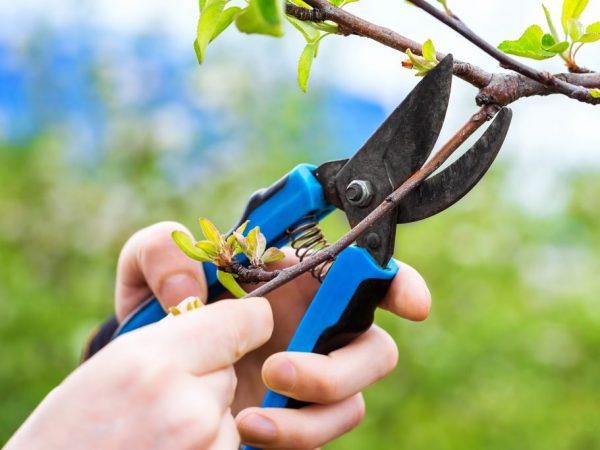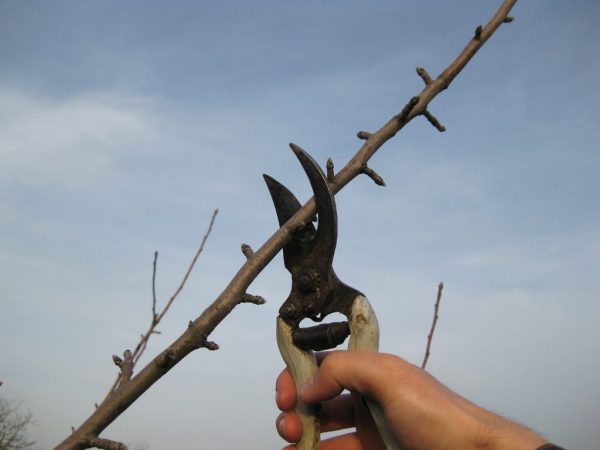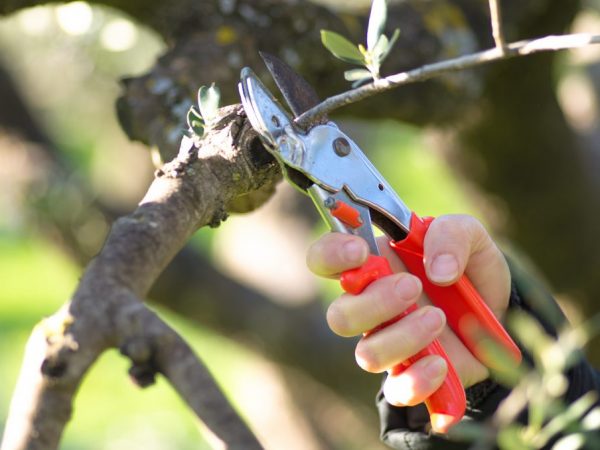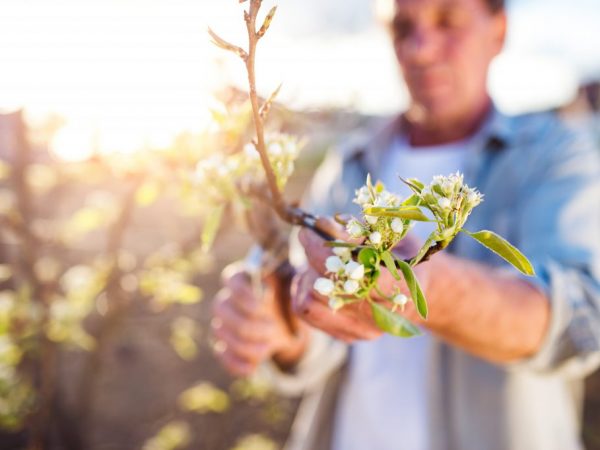Schemes for the formation of the crown of an apple tree
The formation of the crown of an apple tree is a mandatory procedure when cultivating fruit trees. They approach pruning competently, using technologies accepted in horticulture and trying to avoid common mistakes.

Schemes for the formation of the crown of an apple tree
The purpose of forming an apple crown
A pruned apple tree will provide the grower with a richer apple harvest.
Ignoring the formation stage leads to a number of problems.
- The thickening of the foliage makes it difficult for the free circulation of air flows, which leads to the appearance and development of viral, fungal and bacterial diseases;
- Dense foliage significantly increases the risk of breaking off branches and the appearance of long non-healing wounds on the trunks, which become a place for pathogens to penetrate the bark;
- Foliage and branches consume most of the organic matter, so nutrition becomes insufficient for fruits - apples become smaller and lose gastronomic qualities;
- Dense foliage does not allow full penetration of sunlight into the thickness of the green mass, slowing down the ripening of the fruits contained in it, leading to the loss of their gastronomic characteristics and a decrease in yield;
- The branches do not cope with the load from the weight of the fruit, which makes it difficult to care for and subsequent harvest.
Time to form apple trees
The formation of the crown begins one year after planting the apple tree. the root system of a young seedling is not able to deliver the required amount of nutrition to the apex.
Mainly, tall tops are shortened, paying less attention to the lower level. Last year's branches are left intact, tk. they are the strongest and act as a frame.
One-year-old apple trees are shortened by 1/3.
Subsequently, the trees are formed every year, cutting off the branches by 1/4 of the growth. For this, different times are permissible:
- spring - until the beginning of active sap flow (in March-April);
- autumn - the process contributes to the preparation of horticultural crops for the upcoming wintering, freeing them from unnecessary stress;
- in the summer - they do this in rare cases, when there is an increased growth of fresh shoots, trying to cut off everything that grows along the skeleton (skeleton).
It is important to maintain a balance between the number of old branches and new shoots by shortening branches that have grown to the level of the central conductor. The main conductor is left above.
Pruning schemes

The type of pruning is selected depending on the growing conditions
There are several schemes for the formation of the apple tree crown.
Longline discharged
A tier-sparse scheme is used if the distance between trees is 3 m or more. The general view of the apple tree is obtained in the form of a natural layer.
Usually, pruning is started with melting snow, measuring 0.5 m from the surface of the soil. At a height of 0.3 m above the stem, for skeletal branches of the 1st row, an additional mark is made. Anything above these marks must be removed.
A year later, the young shoots that have grown on the stem are removed.
The technology assumes:
- keeping only one branch at the first level;
- the formation of two shoots of the second tier at a distance of 0.15 m from the first;
- selection in the third year of crown formation of the strongest branches growing at a height of 0.5 m above the first tier, they will become the future skeleton of the apple tree, while the main branches are left, and the competing branches are removed, the interval between tiers is maintained at 0.15 m;
- laying a new branch, departing from the fresh level of 0.4 m.
In the following seasons, the main trunk is shortened, keeping the height of the apple tree about 2.5 m.
Cupped
Cup-shaped crown pruning technology is more suitable for low-growing species.
This shaping is suitable for semi-dwarf apple trees.
- Three processes of the first level are formed at an angle of 120 °.
- Paired branches are formed by cutting off the branches extending from the conductor at a distance of 0.4 m.
- The main conductor is shortened over the main branch for cup-shaped pruning. This can be done immediately or in the second or third year of growth, when the skeleton becomes strong.
- In order to avoid overgrowing of the crown core, branches extending into the depths are removed regularly, keeping only small fruiting processes.
Vertical
The scheme is optimal for apple trees growing near the fence.
The formation period covers about 4 years.
At each tier, two branches are kept at the guide, as a result of which the skeletal branches form a flat cap 2 or more meters wide. In this case, the new branches are given an inclined position, and a distance of 0.8 m is maintained between the tiers.

Shoots must be pruned annually.
The height of the apple tree formed by the vertical palmette is regulated by annual pruning of the conductors and shoots.
Fusiform
The spindle diagram assumes a cut of the main conductor to the kidney. Semi-skeletal branches are shortened to the desired level.
The process lasts for 3 years after disembarkation:
- start with pruning one-year-old seedlings (they are cut by 1/3);
- the first tier is formed from the branches located in the middle part of the crown by bending them;
- in the following season, conductors and shoots are pruned, laying a new level;
When the tree crown reaches a height of about 2.5 m, the conductor is cut over any horizontally growing branch, which ensures the growth of the shoots.
If the horizontal branches are growing quickly, the center conductor can be left without pruning. It is worth removing it when it grows to 0.7 m or more. This allows the semi-skeletal branches to grow evenly.
Creeping
For low-growing apple trees, a creeping pruning scheme is more suitable, giving ground-level development to the tree.
Choose a seedling that is small in height and has a flexible stem. Its top is shortened by 0.15 m and the trunk is bent, fixing it in this position.
In summer (more often this is done in June), the first tier is formed from the lateral branches.
In the next season, weak growth is removed, and the remaining branches are shortened, making their length less than the conductor. At the same time, the second tier is formed, bending down each strong branch.
Further care consists of the successive removal of upward-growing shoots.
Bushy
The scheme is suitable for growing apple trees in a confined space.
Cutting seedlings to form them with a bush begins a year after planting. Select 5-6 skeletal processes growing at a distance of 0.15 m from each other. The remaining branches are cut off.
The entire growth is shortened by 1/3, leaving the lower tier longer than the next upper one. The guide is cut down over the top branch when the apple skeleton gets stronger.
Whorled tiered
According to this technology, 5 branches formed by adjacent buds are left on the lower tier. In the second tier, 2 branches are left growing through the bud. The distance between the tiers should be about 0.5-0.6 m.
The conductor is not cut off, but free to develop into a side branch.
Rejuvenating

Pruning helps improve yields
The scheme is intended for long-lived trees. This technology allows for the next few years to keep yields at the proper level, prolong fruiting and ensure the quality characteristics of apples.
Rejuvenating pruning consists in thinning the shoots and cleaning the central part of the crown. Cutting angle –45 °.
- They begin to cut the tree from the top - shorten the trunk, ensuring an even flow of sunlight to all zones of the crown.
- Thin problem, overly thickened zones;
- Branches growing at right angles to the central trunk are removed completely;
The time for rejuvenating pruning is early spring, summer pruning is permissible, when in June the apple tree is cut to the maximum, shortening the branches by 3/4;
After the procedure, the garden culture is watered, the stem is covered with whitewash.
Typical mistakes
Regular and correct formation of a young apple crown ensures the full development of garden culture, lays a good harvest, prolongs fruiting and maintains the size and gastronomic qualities of apples.
The procedure is carried out for several years according to one of the schemes, observing the basic rules.
In the process, they often make typical mistakes that lead to a disruption in the development of garden culture:
- with insufficient pruning and thinning, the crown diameter increases, as a general rule, by autumn, seedlings that have reached 1 year should form at least 4 skeletal branches 0.5 m long;
- when the leading shoot is removed instead of the competing one, the diameter of the tree decreases, as a general rule, they pinch and then completely remove those shoots that compete with the leaders.

